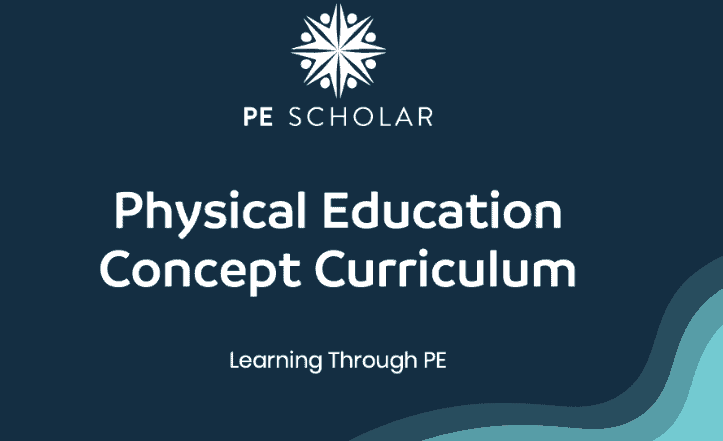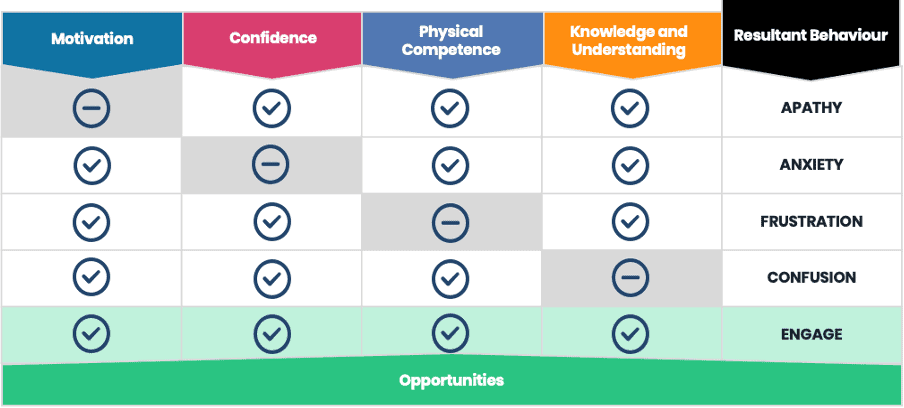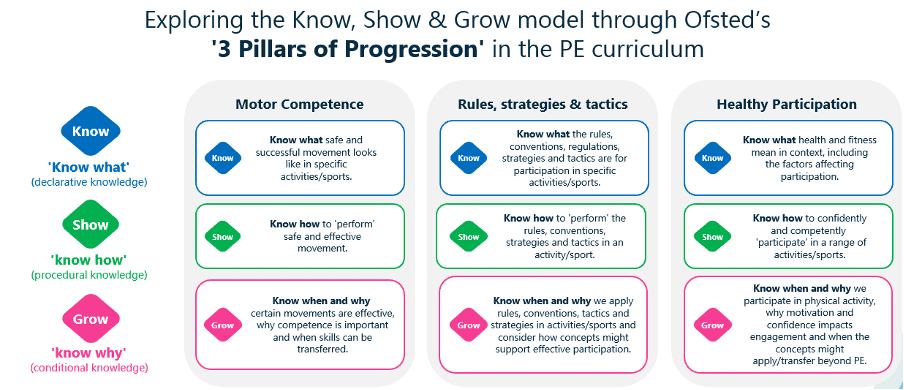
Written by Lee Sullivan and Becky Bridges
The PE Secondary Concept Curriculum (CC) is now being implemented in over 350 schools worldwide. Meanwhile, in response to requests from physical educators, our Primary Concept Curriculum was published in the summer of 2023. Both have been well-received and praised for improving the experiences of students in physical education (PE).
The co-authors of the Secondary CC 2.0, Becky Bridges and Lee Sullivan come together once again to address common misconceptions about this form of holistic and inclusive PE delivery.
It is important to note that Lee and Becky are specifically referring to the Concept Curriculum as published on the PE Scholar website and do not refer to, nor vouch for, any other form of ‘life skills’ or ‘concept-based’ approach to PE delivery.
Misconception 1: The Concept Curriculum Takes Away from the Practical Element of PE
Upon publication of the first Concept Curriculum, we began to hear that some schools were omitting learning within the physical domain in favour of concentrating solely on conceptual aspects. This was the very issue that led to our encounter. Becky had observed instances of ‘concept-driven’ lessons that had lost the essence of physical education entirely. Upon learning this, Lee recognized the need to reassess the established lesson framework to create the L.E.A.D model.
As elaborated later in this blog, the Concept Curriculum’s role should be to engage students who might have otherwise felt disconnected by a less pertinent or attainable lesson focused solely on mastering sports skills or techniques. It’s essential to underline that concept-driven learning doesn’t replace physical or competency development in PE lessons. It’s high time we harnessed the complete potential of sports and physical activity to provide a more substantial and positive learning experience that benefits all and not just those who have already had significant exposure to traditional sports and movement opportunities.
Both the Primary and Secondary Concept Curriculum present uncomplicated lesson delivery frameworks that effectively enable concept-driven learning while ensuring sustained student activity, movement and skill development.

To explore this framework more closely, take a look at the Secondary Concept Curriculum launch video. The framework, along with teachable moments (also discussed in the launch video) ensure students are active for most of the lesson and teachers are working smarter, not harder.
Misconception 2: The CC Fails to Develop Competency
The CC 2.0 introduced three new learning objectives: Know, Show and Grow. The first two learning objectives of Know and Show are focused on students being able to demonstrate the procedural (what) and declarative (how) knowledge as outlined by the Ofsted Research Review (2022). In our experience, these two learning objectives alone can fail to motivate some students and the performance focused objectives can sometimes de-motivate them.
In every PE lesson, we should be aiming to:
- Get the children active for sustained periods of time
- Build positive relationships with physical activity
- Develop movement competency and impart powerful knowledge
We believe that through the CC we can also develop character. However, this should never come at the expense of the three aforementioned aims. If a teacher spends too much time when students should be active discussing a concept (e.g., leadership) then we are missing one of the main aims of our lesson. If a teacher focuses purely on a concept and fails to develop competency then, once again, this is not best practice in PE. The Concept should enhance the first 2 aims and provide the inclusive hook to engage all learning by providing a relevant and meaningful connection to life beyond a specific sporting skill.
Misconception 3: The Purpose of the CC is to Create Resilient Students
The purpose of the CC is not to create more resilient students, to build stronger leaders, to create better listeners, or more employable workers, although we do hope to see these positive outcomes. It’s worth noting that the evidence for such ‘beyond PE’ transfer is a challenge, and even advocates for humanistic physical education like Don Hellison in his work on Teaching Personal and Social Responsibility have grappled with the difficulty of finding concrete evidence for transferability. While other ‘Life Skills’ based curriculums may make claims about this type of learning seamlessly transferring to real-life situations, we are cautious in making such assertions.
Instead, the Concept Curriculum aims to offer an inclusive learning objective (Grow) and supportive delivery framework (LEAD) that resonates with students’ lives and fosters connections with physical education. We recognize the importance of creating learning experiences that are meaningful within the context of PE and, potentially, beyond. By focusing on relevant and relatable concepts, we aim to encourage students to engage more deeply with the subject and, ultimately, embrace physical activity as a lifelong pursuit. While we cannot guarantee specific outcomes, we believe in the power of the CC to contribute positively to students’ personal development and future habits.
Ash Casey supported the work of Stephanie Beni and Tim Fletcher, in his blog from 2018 on meaningful experiences in PE by saying: ‘When young people could recognise the importance of what they were learning and make connections to life outside of the situation – either in the present or future – they came to see their experiences as meaningful.’ This is what a concept curriculum is aiming to do. Shift the learning of the lesson from one that is skill specific that feels irrelevant and unachievable for most, to one which is inclusive, relevant and meaningful for every learner.
Dr Liz Durden-Myers presents the diagram below as part of her presentation on physical literacy informed physical education. The slide highlights the different components of physical literacy and how if a component is missing from delivery or the child then there will be a resultant behaviour. If students lack competence then they may display frustration. If students lack confidence then they be anxious in PE. The Concept Curriculum aims to unlock what is missing for so many, intrinsic motivation to move more. By providing some opportunities to find success and learning that they believe is important in their lives, we can motivate students to want to engage within our lessons and beyond. We are using the Concept Curriculum so that we can develop competence and confidence in and through movement.

Durden-Myers (2020)
We aim to provide learning experiences that will nurture a positive self-identity with physical activity, which could in-turn support future habits in relation to long-term engagement.
Misconception 4: More of the Same
The current and most dominant traditional form of PE delivery is failing to meet this aim of healthier and more active young people and consequently we would argue is not an appropriate model to be meaningful for all learners. In fact, it is often creating a negative self-identity towards physical activity. I know this is not unique to my context or a new problem, David Kirk has been campaigning against the skill-drill and sport technique focused teaching for decades.
It has been argued that by adopting the Concept Curriculum, all we are doing is disguising the traditional form of PE delivery with one that loosely delivers a life skill to be seen as more valuable or relevant. We absolutely do not advocate more of the same.
When addressing this misconception, we should look at the Primary and Secondary Concept Curriculum resources separately.
The Primary Concept Curriculum
When talking with Primary PE leaders, it was clear that they wanted a resource that would provide far more scaffolding and instruction so that those low in confidence or with less experience delivering a PE lesson could still do so effectively. Therefore, we have written the lessons as we believe they should be delivered in order to maximise activity time, develop competency, and learn PE specific concepts that will best set them up for their PE journey ahead. Through immersive stories, exploratory play, fun activities, and no standing waiting for their turn, we have written a resource that we believe will nurture physical literacy and build the foundations for a lifetime of physical activity. We have used various approaches, models (sports education, teaching games for understanding, etc.) and research (meaningful physical education, etc.) to write schemes of work to support all at primary level to provide positive PE experiences for their children so that they have the competency, confidence and motivation to move for years to come.
The Secondary Concept Curriculum
When writing the Secondary Concept Curriculum, we wanted to provide some examples of ways in which teachers might look to apply it. In truth, there is no right way to delivery PE. PE can and should have its multiplicities and context is key. There are lots of different pedagogical approaches and model based practices that can be used alongside the Concept Curriculum. At secondary level, most often those delivering PE are specialists and it would be unfair and controversial to suggest that our way is the only way. We have always emphasised our vision that all students should be active with a need to move away from skill-drill led lessons. PE leaders should apply the Concept Curriculum framework in line with their own curriculum intent and the needs of their students.
Misconception 5: Life Skills are PE’s Responsibility
It is important to correct the misconception that developing life skills are somehow PE’s responsibility. They’re not. Laura Davies, in her blog ‘Physical Education & The Great Health Myth’
raised the important argument that neither is it PE’s responsibility to tackle obesity, mental health or even improve fitness. However, we do believe that PE has the power to support these issues by creating positive experiences and build strong long-lasting relationships with PE, physical activity and sport.
It is said that physical activity should be an end in itself. This is true. But what if one is not motivated to engage in physical activity in the first place? The approach of adopting and delivering a concept curriculum can indeed bring those less engaged into physical activity and begin to nurture physical literacy, by communicating more clearly the meaningful learning taking place within and through physical education.
We acknowledge our own contribution to this misconception as the first Concept Curriculum we had included learning that had no real place in a PE lesson. We addressed some of our learning from the first Concept Curriculum in a blog named ‘The Evolution of the Concept Curriculum’.
Whilst not our responsibility, we are in a great place to be able to focus on PE and sport specific concepts that might be relevant beyond PE too. We can offer something that no other subject can, the chance to be physically immersed in what we are trying to teach. The Centre for Creative Leadership calls this type of learning, ‘heat experiences’, and defines a heat experience as, ‘situations that help leaders discover that their current way of making sense of the world is inadequate. As a result, they seek out new and better ways to make sense of their challenge.’
By introducing a concept and then allowing students time to practice, they will often be placed in a heat experience and get to explore that concept first-hand. For example, a lay-up shot lesson focusing on embracing failure, will provide the opportunity to fail at something, and work out themselves if they will give up or learn from this to improve their technique, and potentially gain some success. This approach offers a positive spin on learning a complex skill that often most will leave a lesson unable to replicate.
Misconception 6: Ofsted do not like the CC
One of the most frequently asked questions we receive is around whether Ofsted approve of the CC or not.
As per the previously mentioned Ofsted PE Research Review (2022), Ofsted identify procedural and declarative knowledge as key to PE.
The CC supports this delivery with the Know and the Show learning objectives. We believe that the CC goes beyond the expectations of Ofsted by offering a third learning objective of Grow. This is conditional knowledge that asks students consider why this learning is important, why does it have meaning in their lives and how can it support them in PE and beyond in the future. Further building on Cultural Capital, one of Ofsted’s key performance measures. It also allows room for the inclusion of other important themes like British and Olympic values or contextually important themes relevant to the school context.

Many of the departments that have successfully implemented the CC and have been ‘Deep Dived’ by Ofsted have had positive feedback if the practical element is sequenced effectively. This is further explored in the Concept Curriculum online course.
Misconception 7: CC takes away from Competition
The Ofsted Research Review (2022) highlights the importance for all students to ‘engage in competitive sports and activities’ and there is a misconception that the CC will be taking away the competitive element of PE lessons.
Applying concept-driven learning to sport does not devalue the sport in any way. Sport is so much more than just techniques, tactics, rules, and competition. Sport is resilience, motivation, communication, and leadership. Sport is winning, losing, challenging yourself, working independently and working with others towards a common goal. As physical educators, we recognise the significance of competition, while also acknowledging the contemporary challenge posed by gamification, instant gratification, and rewards prevalent in the modern world of computer games and social media. These digital influences often deter many individuals from embracing tasks that require effort or patience.
Competition is specifically encouraged as part of the CC through our ‘Character Development’ unit. This unit develops competition, problem solving, sporting values and the power of positivity.
Competition is also referenced throughout all exemplar schemes of work and activities. Competition is certainly not lost; in fact, many concepts are best taught through competition and games. The difference is that the focus is not the outcome of the competition. Instead, the focus is on how to stay positive in the face of competition, how to deal with defeat and staying positive to support the morale of others. It develops the notion of competition and provides more developmentally appropriate competitive environments appropriate to the needs of the pupils.
This also addresses another misconception that the CC has to be the whole PE curriculum. In my context (Lee), we use the CC for the first lesson of the week and the Personality Pathway (discussed in the ‘Exploring Class Grouping in Physical Education’ blog) for the second lesson of the week. Therefore, hopefully highlighting the point that we can provide more direct/focused competition to those that wish for it elsewhere in our PE delivery.
Misconception 8: The CC has no way of assessing progress
Assessment in PE serves dual purposes:
- Firstly, it informs teachers about the learning/ progress being made and aids future lesson planning
- Secondly, it empowers students to comprehend their advancement and apply their learning effectively in diverse contexts.
Contrary to the misconception, the Concept Curriculum (CC) offers various assessment avenues. These include Question and Answer sessions, Teacher Observations, Formative and Summative Assessments. For students, the CC promotes Self-Reflection, Peer Observations, Discussions, and Feedback.
The CC embraces a holistic assessment framework, acknowledging schools’ stringent assessment policies. It delineates three lesson objectives (Know, Show, Grow), targeting cognitive, physical, and affective/ social domains. Formative assessments continually inform summative evaluations, future planning, and instructional delivery.
Furthermore, the CC presents a comprehensive 8-week unit exemplar, adaptable to different settings. It encourages ongoing formative assessment during the unit and integrates ‘Revisit and consolidate’ lessons for reinforcement.
The Ofsted PE Research Review (2022) discussed the challenges that face assessment in PE. Within the document, they mention, ‘Assessment that is based on generic skill progression, for example teamwork or resilience, does not adequately give pupils the component knowledge they need to know more and do more.’ This raised another common misconception that the CC replaces assessing the physical. That is not the case. No PE curriculum should focus solely on ‘life skills’ or ‘character development’. We should be assessing against what we are aiming to achieve in our intent. In PE, movement competence is key so must form a large part of our assessment. Assessing physical ability alone in our experience can alienate and demotivate students. It also overlooks the importance of cultivating other PE/sport specific skills like teamwork, etc. So whilst no PE assessment should be based on generic skill progression, we do have an opportunity to incorporate it into our holistic assessment criteria.
Concluding Thoughts
The CC is not aimed at side lining the vital practical aspects of PE, but rather at enhancing them with relevant concepts, finding a balance between physical development and meaningful learning experiences.
It’s vital to understand that the CC’s primary goal is not about creating resilient students or teaching life skills but about providing inclusive and relevant learning. While it might contribute to these outcomes, its core focus is on nurturing positive self-identities and promoting lifelong engagement in physical activity.
Contrary to misconceptions, the CC is not an attempt to disguise traditional PE delivery but offers a fresh perspective to make PE meaningful for all learners. It aligns with Ofsted’s emphasis on knowledge while going beyond by introducing the Grow objective, fostering a deeper understanding of the importance of learning.
In essence, the Concept Curriculum serves as a supplement to great teaching, infusing education with more meaning, value, and purpose. It encourages a holistic approach that meets the 21st-century needs of students, emphasising the significance of being more human, fostering resilience, and creating meaningful connections for future success in sports and life.
References
Durden-Myers, E.J. Operationalising Physical Literacy within Physical Education Teaching Practice through Professional Development. Ph.D. Thesis, University of Bedfordshire, Bedfordshire, UK, 2020. Available online: https://uobrep.openrepository.com/bitstream/handle/10547/624942/FINAL%20PhD%20Thesis%20Elizabeth%20Durden-Myers%200613136.pdf?sequence=1&isAllowed=y (accessed on 18th August 2023).


Responses